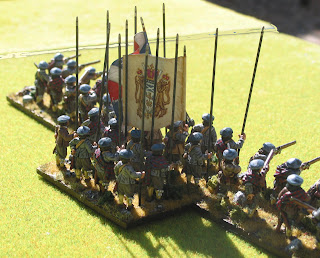The colours used by the Irish are not described at all in any of the contemporary accounts of Montrose's 1644-45 Campaign. There is only a brief mention of MacColla's lifeguard carrying a yellow colour at the Battle of Auldearn.
This has been interpreted by Nigel Tranter in his fictional account of the campaign as being the King's Standard (a red rampant lion on a yellow field), which MacColla carried to attract the attention of the covenanters while Montrose rallied the rest of the Royalist army. Stuart Reid, not unreasonably, supposes that the Irish would have carried colours similar to those described for the Irish Confederacy forces in the Ireland, and that the yellow colour is one of 12 colours described in the contemporary gazette, "The True Informer".
Reid lists the descriptions of all 12 colours in his book "Scots Armies of the C17th. III: The Royalist Armies, 1639-46" (published by Partizan Press). Two of those descriptions form the basis for the colours given to my first Irish Regiment. Most of the colours have overt catholic imagery, and latin religious mottos, both features that would not have endeared them to the presbyterian burghers of Scotlands towns and cities.
All of the colours are thought to have featured a red saltire on a yellow field in the canton, and the Royal Crown and cypher (CR), together with the latin motto "Vivat Carolus Rex", or "long-live King Charles".

The first is a green sheet, with "Christ carrying his cross on his shoulder", and the motto "PATIOR UT VINCAM", which translates as "I suffer so that I may conquer".

The second colour is a red sheet with "the name of Jesus", which I have chosen to interpret as meaning the common Catholic abbreviation "IHS" for "Iesus Hominum Saviour", or "Jesus, Savior of men". The motto on this sheet is "IN NOMINE JESUS OMNE GENU FLECTITUR", which loosely translates as "In the name of Jesus all knees shall bend".
At this time, fear of the Roman church ran so deep, that just having an Irish accent in Scotland could prove fatal. So Montrose's use of Catholic Irish mercenaries to press the King's will in Scotland could not have gone down well with the locals, and no doubt these colours fluttering over his victorious army would not have helped matters.
Both flags were made in photoshop, and printed on paper. They were subsequently entirely painted over, to give them the hand-painted look. They were also cut to give a torn and ragged campaign look. More flags to come. Next: MacColla's Lifeguard.















































